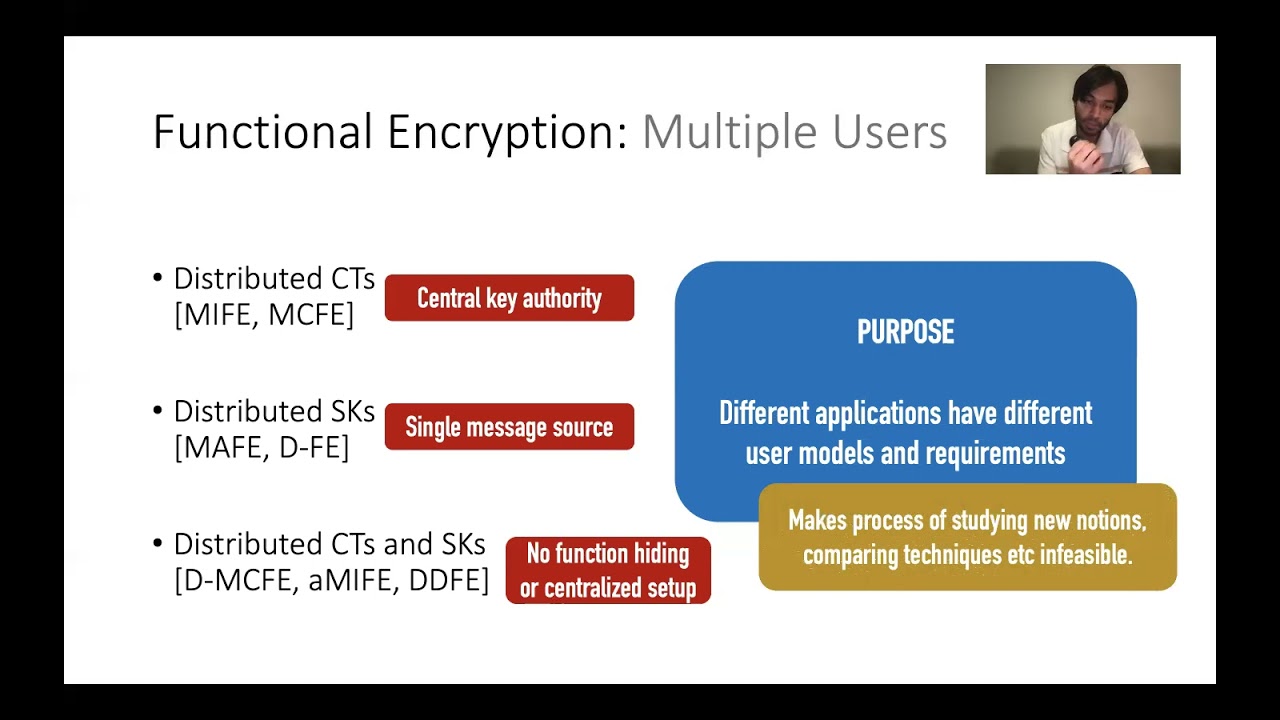Welcome to the resource topic for 2020/1266
Title:
Multi-Party Functional Encryption
Authors: Shweta Agrawal, Rishab Goyal, Junichi Tomida
Abstract:We initiate the study of multi-party functional encryption (MPFE) which unifies and abstracts out various notions of functional encryption which support distributed ciphertexts or secret keys, such as multi-input FE, multi-client FE, decentralized multi-client FE, multi-authority FE, dynamic decentralized FE, adhoc multi-input FE and such others. Using our framework, we identify several gaps in the literature and provide some constructions to fill these: 1) Multi-Authority ABE with Inner Product Computation: The recent work of Abdalla et al. (ASIACRYPT’20) constructed a novel composition'' of Attribute Based Encryption (ABE) and Inner Product Functional Encryption (IPFE), namely functional encryption schemes that combine the access control functionality of attribute based encryption with the possibility of performing linear operations on the encrypted data. In this work, we extend the access control component to support the much more challenging multi-authority setting, i.e. lift’’ the primitive of ABE in their construction to multi-authority ABE for the same class of access control policies (LSSS structures). This yields the first construction of a nontrivial multi-authority FE beyond ABE from simple assumptions on pairings to the best of our knowledge. Our techniques can also be used to generalize the decentralized attribute based encryption scheme of Michalevsky and Joye (ESORICS’18) to support inner product computation on the message. While this scheme only supports inner product predicates which is less general than those supported by the Lewko-Waters (EUROCRYPT’11) construction, it supports policy hiding which the latter does not. Our extension inherits these features and is secure based on the k-linear assumption, in the random oracle model. 2. Function Hiding DDFE: The novel primitive of dynamic decentralized functional encryption (DDFE) was recently introduced by Chotard et al. (CRYPTO’20), where they also provided the first construction for inner products. However, the primitive of DDFE does not support function hiding, which is a significant limitation for several applications. In this work, we provide a new construction for inner product DDFE which supports function hiding. To achieve our final result, we define and construct the first function hiding multi-client functional encryption (MCFE) scheme for inner products, which may be of independent interest. 3. Distributed Ciphertext-Policy ABE: We provide a distributed variant of the recent ciphertext-policy attribute based encryption scheme, constructed by Agrawal and Yamada (EUROCRYPT’20). Our construction supports NC^1 access policies, and is secure based on ``Learning With Errors’’ and relies on the generic bilinear group model as well as the random oracle model. Our new MPFE abstraction predicts meaningful new variants of functional encryption as useful targets for future work.
ePrint: https://eprint.iacr.org/2020/1266
Talk: https://www.youtube.com/watch?v=pgJahGa3hvA
Slides: https://iacr.org/submit/files/slides/2021/tcc/tcc2021/167/slides.pptx
See all topics related to this paper.
Feel free to post resources that are related to this paper below.
Example resources include: implementations, explanation materials, talks, slides, links to previous discussions on other websites.
For more information, see the rules for Resource Topics .
